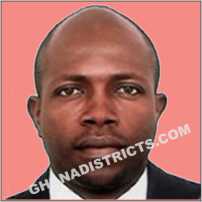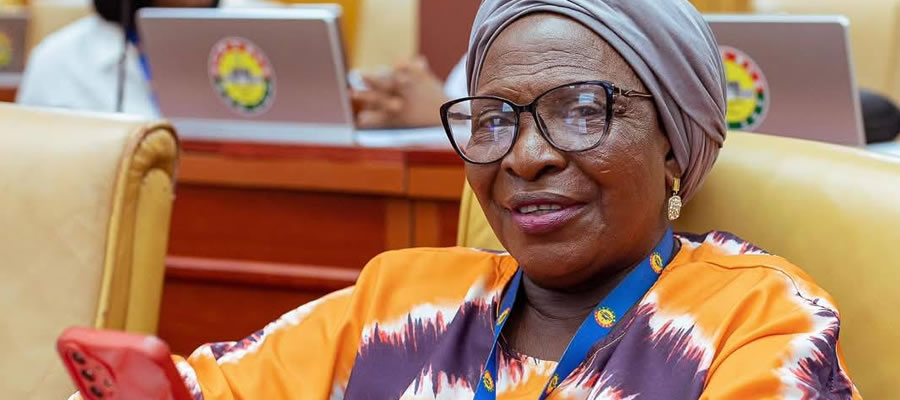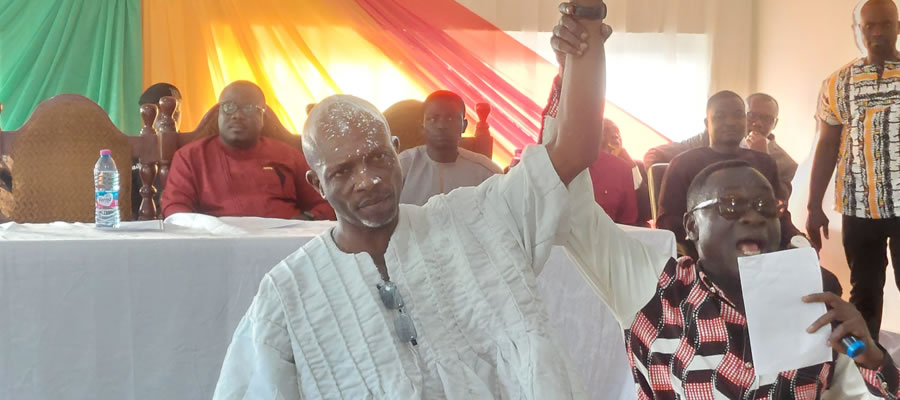

Ghana’s decentralization program began in 1988 with an objective to promote effective and accountable local government in Ghana. District Assemblies (DAs) - the local government units have been designated:
• The highest political Administrative Authority
• Planning Authority
• Development Authority
• Budgeting Authority
• Finance and Administration.
Consequently, The DAs have been given strategic functions that empower them to provide de-concentrated and devolved local public services and to be responsible for overall development of the district.
Dormaa East District Assembly Structure and Functions
The Dormaa East District Assembly was established by a Legislative Instrument (L.I 1851). It has 29 Assembly Members, (1) Member of Parliament (MP) with one constituency and one Traditional Council i.e. Dormaa Traditional Council. There is one (1) Town Council at Wamfie and four (4) Area Councils. There are 19 Electoral Areas.
The District Assembly is the highest administrative and planning authority in the district. It was carved out from the then Dormaa District. The legal instrument which establishes the district assembly is Legislative Instrument (L.I 1851) of 2007. The District Assembly is however in a rented administration block and staff quarters which are draining the coffers of the Assembly yearly.
The Functions of the District Assembly
The functions of the District Assemblies are basically derived from statute, as mandated by Local Government Act 462 of 1993 and Legislative Instrument No. 1408 of 1988 which created it. These functions which are broadly aimed at attaining its objectives and fulfilling its mission of improving the quality of life of its people are:
- Be responsible for the overall development of the district and ensure the preparation and submission of development plans and budget to the relevant central government Agency / Ministry through the Regional Co-ordinating Council (RCC).
- Formulate and execute plans, programmes and strategies for the effective mobilization of the resources necessary for the overall development of the district.
- Promote and support productive activity and social development in the district and remove any obstacles to initiative and development.
- Initiate programmes for the development of basic infrastructure and provide municipal works and services in the district.
- Be responsible for the development, improvement and management of human settlements and the environment in the district.
- In co-operation with the appropriate national and local security agencies, be responsible for the maintenance of security and public safety in the district.
- Ensure ready access to courts and public tribunals in the district for the promotion of justice.
- Initiate, sponsor or carry out such studies as may be necessary for the discharge of any functions conferred by Act 462 or any other enactment.
- Perform such other functions as may be provided under any other enactment.
To effectively and efficiently perform these functions, the Assembly requires variety of skills and professionals to man its various places of duty created to operate its organisation structure.
The District Planning Coordinating Unit (DPCU) however, advises and provides a secretariat for the planning authority in its planning, programming, monitoring, evaluating and coordinating functions. The Executive Committee however, shall co-ordinate plans and programs of the sub-committees and submit these as comprehensive plans of action to the District Assembly. Fig 5: below shows the existing structure of the Dormaa East District Assembly.
District Assembly Members
The District Assembly is the legislative and deliberative body in the District. There are twenty-eight (28) members in the Dormaa East District Assembly. The Assembly Members who represent the various electoral areas are twenty-one (21) whilst the government appointees are seven (7). Women constitute seven (7) of the twenty-eight (28) Assembly Members which implies that there is the need to empower women in the District to be involved more in the governance and decision making process.
The Executive Committee
The Executive functions of the Assembly are performed by the Executive Committee, which is presided over by the District Chief Executive (DCE). It is made up of eleven (11) members; eight (8) males and three (3) females. Its functions include:
- co-ordinate plans and programmes of the sub-committees and submit these as comprehensive plans for action to the District Assembly;
- implement resolutions of the District Assembly;
- oversee the day to day administration of the District in collaboration with the office of the District Chief Executive;
- recommend, in the case of non-decentralised agencies in the District, to the appropriate Government Ministry/Department/Agency the appoint and replacement on stated grounds of officers within the area of authority of the Assembly;
- adopt measures to develop the activities and execute approved plans of the units, areas and towns and sub-metropolitan districts within the area of authority of the district Assembly; and
- when necessary appoint or dissolve ad-hoc committees of the Executive Committee.
Sub-committees of the Executive Committees and their Functions
The sub-committees of the Executive Committee perform the following functions:
Development Planning Sub-committee
This arm of the sub – committee is to ensure general development in the District. To achieve this, it thus performs the following functions:
- Takes a comprehensive look at the District;
- Identifies the economic resources / potentials of the district;
- Develops an information base on the resources;
- Identify opportunities and constraints for the exploitation of these resources;
- Prepares exploitation and phasing plans and strategies;
- Consults with other sub – committees and the private sector for the implications the proposed District plan may have on other sub–committees plans;
- Submits the plan to the executive committee for harmonization with other sub –committee plans.
Finance and Administration Sub-committee
This sub – committee is very important to the District Assembly because it forms an essential and sensitive component of the District without which the performance of the District would be questionable. It performs the following functions:
- Examines the general financial position of the Assembly;
- Examines the revenue mobilizations and expenditure trends of the Assembly;
- Maps out strategies to improve revenue mobilization in the present and sets targets for the future;
- Submits financial plans to the executive committee for harmonization with other sub – committee plans;
- Identifies strategies to ensure judicious utilization of available resources.
Justice and Security Sub-committee
This sub – committee is set up to resolve intra – district and inter – districts conflicts and to consider issues that pertain to the enforcement of bye laws of the Assembly.
To achieve this, the sub – committee;
- Examines these and other related conflict areas;
- Recommends to the executive committee ways and means to resolve disputes;
- Ensures ready access to the courts and tribunals for the promotion of justice in the district, making sure that premises are available for use by community tribunals, that police logistics are adequate etc.
Works Sub-committee
The functional areas of the works sub – committee include roads, electricity, sanitation, water etc. Within the general framework of Act 462 and the specific functions in the legislative instruments that establish the various Assemblies.
The sub – committee does the following:
- Takes comprehensive look at the infrastructure needs and problems of the district;
- Develops an information base on each of these program / functional areas;
- Maps out, initiates and phases out programs for their development and / or provision;
- Examines the implications of such actions for the other sub – committee proposals;
- Submits the programs to the executive committee for harmonization and action.
Social Services Sub-committee
It aims to achieving development and progress in the various social sectors of the District. It thus performs the following functions:
- Takes a comprehensive and long term look at areas of social development in the district, in particular education, health, social welfare, sports, culture etc;
- Develops the information base on these areas of social development;
- Identifies the strengths and weaknesses in the social services areas;
- Prepares a social development plan (long, medium and short term), for the district;
- Examines the implication of the social development plan on other sub – sectors of the district economy;
- Submits the plans to the executive committee for harmonization.
Administrative Structure of the District Assembly
The central administration of the District Assembly is primarily responsible for the day to day management of the Assembly. These include the preparation of plans and the mobilization and management of resources for the development of the District.
The central administration has the DCE as the political head followed by the District Co-ordinating Director. The works department, planning, budget, finance and other decentralized departments constitute the line management that channels their grievances to the DCE through the DCD.
The works department has the labourers and the building inspection sub – divisions where as local government inspectorate, account office and the chief revenue supervisor are monitored by the finance office. The registry coordinates and monitors the movement of files from one department to the other. Fig 6: below depicts the Organogram of the Central Administration of the Dormaa East District Assembly.
Apart from the above departments, there are others which are present in the District including National Commission for Civic Education (NCCE), Non formal Education Division (NFED) and the Ghana Police Service.
Major Actors of the District Assembly
The key actors of the district assembly as specified in the Local Government Act (Act 462), 1993, are responsible for the management, administration, control and overall development of the District. Their actions play a major role in the development planning process and management of the district assembly. These include the roles and activities of the
District Chief Executive
District Coordinating Director
District Finance Officer
District Planning Officer
District Engineer
District Budget Officer
Sub-District Structures of the District
Town and Area Councils
There are five (4) Area Councils and one (1) Town Councils in the Dormaa East District. These include:
• Wamfie Town Council
• Wamanafo Area Council
• Kyeremasu Area Council
• Asuotiano Area Council
• Dormaa Akwamu Council
Functions of the Town and Area Councils
The functions performed by the town / area council are:
- The collection of revenue for the District Assembly
- Implementation of bye – laws
- Organization of communal labour
- Undertake area or community initiated projects
- Perform oversight responsibility of community initiated projects, among others.
Update on Disbursements from funding sources
The main sources of Revenue for Financing Development Programme at the District level are generated from Central Government transfers and Internally Generated Funds by the District Assembly. The table below depicts the Revenue Sources of the District
The table indicates that the DACF is by far the biggest contributor of funds to the District for Development. The contribution of the DACF is about half of all revenue flowing into the District. The DACF has emerged as the major reliable source of funding for the Implementation of District Development Project or Programmes. The total release of funds in 2009 was GH 726,378.72.
Comment on:
(a) The releases were duly delayed. The DACF though, the biggest contributor of funds to the District for Development has not been adequate to support all programmes and activities of the Assembly. The IGF which is poorly generated has not been much reliable for the District to carry out most of its Developmental Programmes and Projects.
(b) Adequate efforts are being made to talk to the government to release funds on time. Again, there is an on-going exercise to educate the people on the need to pay their taxes. The Assembly is also putting measures in place to seek financial assistance from Donors to support developmental projects in the district.
(c) With regards to funds generation, The District is basically dominated by farmers whose incomes are difficult to determine. This makes it extremely difficult fixing high rate and taxes.
On disbursement, the main area was on administrative expenses as depicted in table 3.6 below.
Comment on:
(d) The Funds are virtually not adequate for the District to carry out its Developmental Programmes and Projects.
(e) Could not go strictly by the budget because of some directives from Central Government.
Inadequacy and untimely release of funds have been the major problems confronting all the Assemblies.
Date Created : 11/16/2017 2:30:30 AM












 facebook
facebook
 twitter
twitter
 Youtube
Youtube
 +233 593 831 280
+233 593 831 280 0800 430 430
0800 430 430 GPS: GE-231-4383
GPS: GE-231-4383 info@ghanadistricts.com
info@ghanadistricts.com Box GP1044, Accra, Ghana
Box GP1044, Accra, Ghana